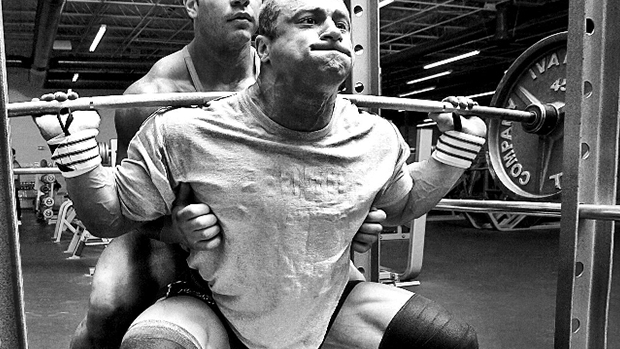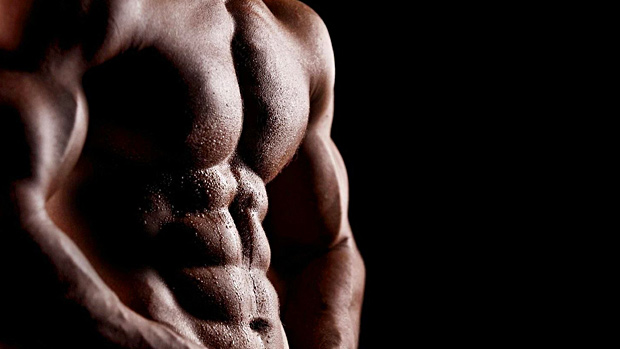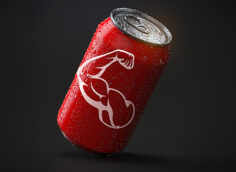A few months ago I was in Colorado with Chris Shugart to visit our uberboss, Tim Patterson, to talk about some new projects. While our days were booked solid, one thing really stuck in my mind. And the funny thing is that it wasn't even something we discussed in our meetings!
You see, Tim is an amazingly busy person and receives phone calls from experts in various fields just about as frequently as Shugs thinks about sex.
And it was one of these phone calls that has my ears still ringing.
I only overheard bits and pieces, but the conversation revolved around the amino acid leucine and how it makes each meal anabolic, helping one gain muscle even on a fat loss diet. As you might imagine, my interest was piqued, and I couldn't wait for the call to end to see what was up.
It turns out that this was the conversation that would start the Biotest leucine project.
You've probably read the report already, but the bottom line is that leucine is a direct signal that initiates the muscle-building process. When taken with a meal, leucine drastically jacks up protein synthesis, reduces muscle breakdown, and well, it basically makes you put on mucho mass.
Essentially, leucine turns every meal into an anabolic feast!
A Real Life Test for Leucine
I read the literature, and I was obviously curious to see if the science would deliver in the real world. To say that I was a bit skeptical is an understatement; I'm well aware of the power of certain individual amino acids, but still, it sounded too good to be true.
Well, life threw something my way that allowed me to test leucine's capacity to prevent muscle loss, and even lead to muscle gain, under the worst of circumstances.
It all started three weeks ago when I was hospitalized for six days.
What happened? Well, during my honeymoon in Aruba, it seems that I caught some sort of virus from a pissed off mosquito.
By the way, speaking of the honeymoon, let me present to you the love of my life, Genevieve (try to pronounce that you non-French-speaking guys!).
Anyway, back to my hospital story.
The symptoms from the mosquito-bite virus showed up three days after my return – I had problems breathing, and I was always tired. It pretty much subsided after a few days, so I assumed that it was bronchitis or something.
But due to my work schedule and training, my immune system crashed and the virus struck again. This time my body wasn't able to fight it, and it actually infected my heart. Long story short, my heart was struck so hard that it wasn't strong enough to pump all of the blood out of my lungs, and I basically ended up incapable of breathing.
So, for six days, I was hospitalized without the ability to do any physical activity (they even gave me a bottle to pee in, so I wasn't even standing up to go to the bathroom). On top of that, they expected me to subside on three poorly designed meals per day (although my wife was able to sneak in some Finibars after day two – thanks, honey).
I was deathly afraid of losing size (oh yeah, and my life too), so I a supplement that contained a good dose of L-Leucine (Biotest BCAA) five times a day with my meals or bars.
Part of my treatment included daily weigh-ins, and before this my weight was 222 pounds. Want to know what happened to my bodyweight after donning the hospital gown?
- Day 1: 214 pounds (they put me on diuretics to flush the edema)
- Day 2: 218 pounds
- Day 3: 221 pounds
- Day 4: 223 pounds
- Day 5: 223 pounds
- Day 6: 225 pounds
And the funny thing is that I was actually leaner when I got out than when I went in.
So, not only did I not lose any muscle, I might actually have gained some! Obviously, the muscle gained was from the fact that I was surcompensating from the previous week's training, but still, the catabolic situation of not moving, being ill, and eating around 1,800 calories per day should've left me at least a bit smaller, which was not the case.
And I can somewhat relate this to a previous hospital experience during which I had lost nine pounds in five days.
That's when I started to think that this leucine thing was for real. So, after I got out of the hospital, I added it to my regular supplement regimen.
What's the call so far?
I'm currently 229 pounds upon waking up and leaner than I normally am in the 215 to 220 range. But the most notable effect is that the pumps are so intense that I actually have to support my arms on something between sets to be able to handle the pain!
Thibs' Current Supplementation Plan
Morning (Breakfast)
Pre-Workout
- 1 serving of Plazma™
During Workout
- 2 serving of Plazma™
Post-Workout
- 1 serving of Mag-10®
Before Bed (45 Minutes Prior)
- 2 scoops of Metabolic Drive® Protein
- 4 Flameout® capsules
- ZMA®
Along with the above, I take one serving of BCAA with all of my main meals.
Thibs' Current Menu
By the way, those interested in my current diet, it looks like this. You'll notice that I'm having more carbs than usual, as I'm training to put on more size so that I'll be able to make it through the tough Canadian winter.
Breakfast
- 2 scoops of Metabolic Drive® Protein
- 150-200 grams of turkey
- 1 orange
- A handful of cherry tomatoes
- Spinach
AM Snack
- 2 fat-free organic yogurts
- 1 Finibar
- 100 grams of pineapple
Lunch
- 200-250 grams of chicken
- 75 grams of almonds
- Spinach and romaine lettuce
- A handful of cherry tomatoes
My peri-workout meals start around 2 PM since this is the time I train.
PM Snack
- 2 scoops of Metabolic Drive
- 1 apple
- 50 grams of almonds
- Spinach and romaine lettuce
Dinner
- 200-250 grams of salmon
- 200 grams of berries
- Spinach, cucumber, lettuce, and tomato salad
Evening Snack
- 75 grams of mixed nuts
- 2 whole omega-3 eggs
- 1 fat-free organic yogurt
Before Bed
- 2 scoops of Metabolic Drive
- Spinach, cucumber, lettuce, and tomato salad
I always have a Metabolic Drive protein shake ready in the fridge just in case I wake up during the night. I don't recommend waking up on purpose to eat, as it breaks the sleep cycle and can be detrimental to cortisol and growth hormone levels. But if I wake up for some reason, I drink the shake.
Holistic Training... Or Holy Shit Strength Training?
For those of you who've had your fill of pills, powders, and grams of chicken, here's a training plan that'll have you yelping, "Holy shit!"
One of the better lines I've heard came from the top guy in the business, Charles Poliquin, who once said, "If a coach needs to resort to gimmicky methods, it's because he isn't smart enough to get someone strong."
This is very true indeed. The job of a strength coach is to make someone stronger and more muscular. Those who aren't good at that endeavor (they're normally the ones that hardly look like they've ever set foot in a gym) often dismiss the real value of strength because they don't know how to increase it and resort to gimmicky equipment and baseless methods to attract clients.
So, keep that thought in mind when I talk about holistic training. Holistic refers to a type of training that targets a wide array of physical capacities. Most of the time holistic training falls into the "I can't coach strength, so I'll use brightly colored gizmos and cool looking programs" category.
However, the holistic method that I'll describe, and the one that I'm using with a lot of clients with great success, refers to training various aspects of strength in the same workout; not doing endurance running on a Bosu ball while juggling a pair of kettlebells!
Specifically, the system revolves around building:
- Concentric strength: The capacity to overcome (lift) an external resistance by using your voluntary effort.
- Eccentric strength: The capacity to control/decelerate an external resistance while lowering it.
- Isometric strength: The capacity to produce as much force as possible while the muscle stays the same length (no movement).
- Strength-speed: The capacity to maximally accelerate an external resistance.
- Strength-stability: The capacity to generate a high level of force under unstable circumstances, or the capacity to recover your balance by using force.
I normally use an upper/lower split with this type of training, plus a regular bodybuilding workout for the guns. So, a training cycle will look like this:
- Day 1: Torso 1
- Day 2: Legs 1
- Day 3: Arms
- Day 4: Off
- Day 5: Torso 2
- Day 6: Legs 2
- Day 7: Off
The workouts are structured as follows:
Torso 1
| Exercise/Method | Sets | |
| A1 | Pushing strength-speed | 3-4 |
| A2 | Pulling strength-speed | 3-4 |
| B1 | Pushing concentric strength | 3-4 |
| B2 | Pulling concentric strength | 3-4 |
| C1 | Pushing isometric strength | 3-4 |
| C2 | Pulling isometric strength | 3-4 |
Legs 1
| Exercise/Method | Sets | |
| A1 | Quads strength-speed | 3-4 |
| A2 | Hips/hamstrings strength-speed | 3-4 |
| B1 | Quads concentric strength | 3-4 |
| B2 | Hips/hamstrings concentric strength | 3-4 |
| C1 | Quads isometric strength | 3-4 |
| C2 | Hips/hamstrings isometric strength | 3-4 |
Arms
| Exercise/Method | Sets | |
| A1 | Triceps strength move (4-6 reps) | 3-4 |
| A2 | Biceps strength move (4-6 reps) | 3-4 |
| B1 | Triceps functional hypertrophy (6-8 reps) | 3-4 |
| B2 | Biceps functional hypertrophy (6-8 reps) | 3-4 |
| C1 | Triceps hypertrophy (8-12 reps or special technique) | 3-4 |
| C2 | Biceps hypertrophy (8-12 reps or special technique) | 3-4 |
Torso 2
| Exercise/Method | Sets | |
| A1 | Pushing strength-speed | 3-4 |
| A2 | Pulling strength-speed | 3-4 |
| B1 | Pushing strength-stability | 3-4 |
| B2 | Pulling strength-stability | 3-4 |
| C1 | Pushing eccentric strength | 2-3 |
| C2 | Pulling eccentric strength | 2-3 |
Legs 2
| Exercise/Method | Sets | |
| A1 | Quads strength-speed | 3-4 |
| A2 | Hips/hamstrings strength-speed | 3-4 |
| B | Lower body strength-stability | 3-4 |
| C1 | Quads eccentric strength | 2-3 |
| C2 | Hips/hamstrings eccentric strength | 2-3 |
The amount of rest should be around 90 to 150 seconds between sets, maybe up to 180 seconds if your conditioning is lacking or if you're going for a max lift.
Exercise Bank
Here are some exercises and/or methods to use for each strength category:
Strength-Speed
- Upper body push: push press (3-6 reps), push jerk * (2-5 reps), speed bench with 40-50% of maximum (2-5 reps, you can use added resistance from elastic bands or chains), dumbbell push press (3-6 reps), dumbbell jerk (2-5 reps), medicine ball throw from chest (8-10 reps), plyometric push-ups (8-10 reps). The difference between a push press and a push jerk is that in a push press you use a slight leg drive to get the bar started, while in the push jerk you use a powerful leg drive.
- Upper body pull: jump pull-ups * (3-6 reps), jump chin-ups * (3-6 reps), assisted speed pull-ups (use elastic bands or a partner, 3-6 reps), assisted speed chin-ups (3-6 reps), speed one-arm rowing with bands (3-6 reps). In the jump pull-up or jump chin-up, start each rep standing below the chin station. Jump in the air and grab the bar (you should catch it with your elbows bent at 90 degrees) and immediately pull yourself to the completed position as fast as you can. Basically, you use the jump to cheat and do a more explosive pull.
- Quads: jump squat with 20% of your max (8-10 reps), jump squat with 30% of your max (4-6 reps), jump lunges with 20-30% of bodyweight (3-6 reps per side), speed squat with 40-50% of your max (2-5 reps, you can use added resistance from elastic bands or chains), depth jumps (6-8 reps)
- Hips/hamstrings: jump good morning with 20% of your max (8-10 reps), jump good morning with 30% (4-6 reps), power clean from hang (2-5 reps), power clean from blocks (2-5 reps), power snatch from hang (2-5 reps), power snatch from blocks (2-5 reps), broad/horizontal jump (8-10 reps), dumbbell swing (3-6 reps)
Concentric Strength
- Upper body push: bottoms-up bench press cluster (in the power rack, starting on safety pins in the bottom position, sets of 5 reps with 7-10 seconds of rest between reps), partial bench press in the power rack cluster (same as the bottoms-up bench, but with the bar starting at mid-range), bottoms-up military press cluster, floor press (4-6 reps), floor dumbbell press (4-6 reps), bench press (4-6 reps), incline bench press (4-6 reps), decline bench press (4-6 reps), weighted dips (4-6 reps)
- Upper body pull: dead-hang pull-ups cluster, dead-hang chin-up cluster, dead-hang parallel grip pull-ups cluster, weighted pull-ups (4-6 reps), weighted chin-ups (4-6 reps), one-arm dumbbell rows (4-6 reps), bent-over barbell rows (4-6 reps)
- Quads: bottoms-up front squat cluster, bottoms-up back squat cluster, partial front squat cluster, snatch-grip deadlift cluster, partial back squat cluster, back squat (4-6 reps), front squat (4-6 reps), snatch-grip deadlift (4-6 reps), leg press (4-6 reps)
- Hips/hamstrings: sumo deadlift cluster, conventional deadlift cluster, partial deadlift (just below knees) cluster, partial sumo cluster, sumo deadlift (3-5 reps), Romanian deadlift (4-6 reps), conventional deadlift (3-5 reps), good morning (4-6 reps), glute-ham raise (6-8 reps)
Isometric Strength
- Upper body push: functional isometric bench press (6-9 seconds), overcoming isometric bench press (9-12 seconds), yielding isometric bench press (15-20 seconds), iso-dynamic bench press (regular bench press with a 5-second pause 2 inches from the chest, 3-5 reps), functional isometric overhead press (6-9 seconds), overcoming isometric overhead press (9-12 seconds), yielding isometric overhead press (15-20 seconds), overhead press with a 5-second pause at nose level, 3-5 reps)
- Upper body pull: yielding isometric chin-ups (15-20 seconds), yielding isometric pull-ups (15-20 seconds), iso-dynamic lat pull-down (5-second pause at the end of the pull, 3-5 reps), iso-dynamic seated rowing (5-second pause at the end of the pull, 3-5 reps)
- Quads: functional isometric back squat (6-9 seconds), overcoming isometric back squat (9-12 seconds), yielding isometric back squat (15-20 seconds), iso-dynamic back squat(regular back squat with a 5-second pause in the bottom position, 3-5 reps), functional isometric front squat (6-9 seconds), overcoming isometric front squat (9-12 seconds), yielding isometric front squat (15-20 seconds), iso-dynamic front squat (regular front squat with a 5-second pause in the bottom position, 3-5 reps)
- Hips/hamstrings: functional isometric deadlift (6-9 seconds), overcoming isometric deadlift (9-12 seconds), yielding isometric Romanian deadlift (15-20 seconds), iso-dynamic Romanian deadlift (5- second pause in the low position, 3-5 reps), iso-dynamic good morning (3-5 reps), yielding isometric leg curl (9-12 seconds), iso-dynamic leg curl (5-second hold at the peak contraction position, 3-5 reps)
Eccentric Strength
- Upper body push: super slow eccentric bench press (8-10 seconds eccentric, normal lifting, 3-5 reps), manual accentuated eccentric (partner pushes down on the bar during eccentric, releases during concentric, 4-6 reps), eccentric-only dips for max reps (as many reps as you can while lowering in 5-8 seconds), heavy eccentric-only dips (5 seconds down, 1-3 reps), eccentric-only bench press (down in 5 seconds, 1-3 reps), three-pause bench press (three 3-second pauses during the eccentric portion: start of lowering phase, mid-range, and 2 inches from the chest, 3-5 reps), all of these can also be done on the incline or decline bench press.
- Upper body pull: eccentric-only chins-ups for max reps (as many reps as you can while lowering yourself in 5-8 seconds), eccentric-only pull-ups for max reps, eccentric-only chin-ups/heavy (5 seconds down, 1-3 reps), eccentric-only pull-ups/heavy, three pauses lat pulldown ( three 3-seconds pauses during the eccentric portion of the movement), three pauses seated rowing.
- Quads: superslow eccentric back squat (8-10 seconds eccentric, normal lifting, 3-5 reps), eccentric-only back squat (5-8 seconds down, 1 rep), eccentric-only front squat (down in 5-8 seconds, 1 rep), three-pause back squat (three 3-second pauses during the eccentric portion: start of lowering phase, mid-range, bottom position, 3-5 reps), three-pause front squat, superslow leg press (8-10 seconds eccentric, normal lifting, 3-5 reps), leg press 2/1 technique (lift with two legs, lower with one leg in 5 seconds).
- Hips/hamstrings: superslow eccentric Romanian deadlift (8-10 seconds eccentric, normal lifting, 3-5 reps), superslow eccentric good morning (8-10 seconds eccentric, normal lifting, 3-5 reps), eccentric-only Romanian deadlift (down in 5-8 seconds, 1 rep), three-pause Romanian deadlift, (three 3-second pauses during the eccentric portion: start of lowering phase, mid-range, bottom position, 3-5 reps), leg curl 2/1 technique (lift with two legs, lower with one leg in 5 seconds).
Strength-Stability
- Upper body push: Swiss ball push-ups, push-up with hands on two Swiss balls, blast strap push-ups, blast strap flies
- Upper body pull: blast strap horizontals, blast strap chin-ups, horizontal row feet on a Swiss ball
- Lower body: Siff lunges (lunges on the balls of the feet at all times), split-squat front foot on wobble board, split-squat on sit-fit
So Simple, So Brutal, So Effective
The system is mighty simple. Just use the template and plug in the exercises in the proper place (select one per category).
Oh, and one last thing: Enjoy the growth spurt.





